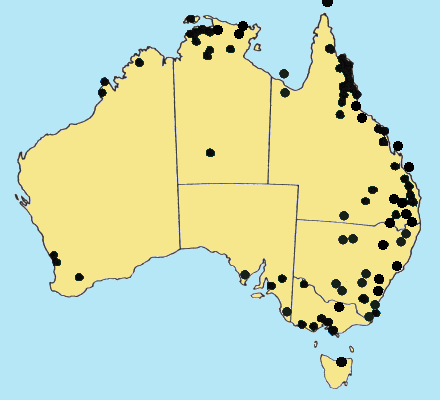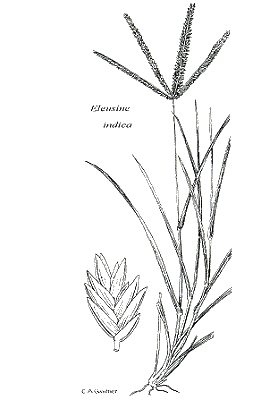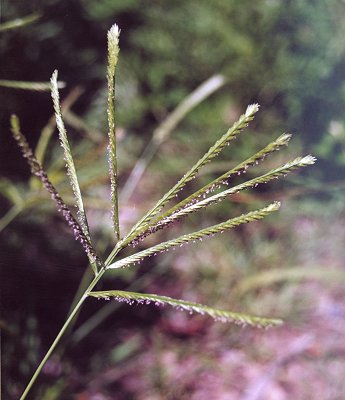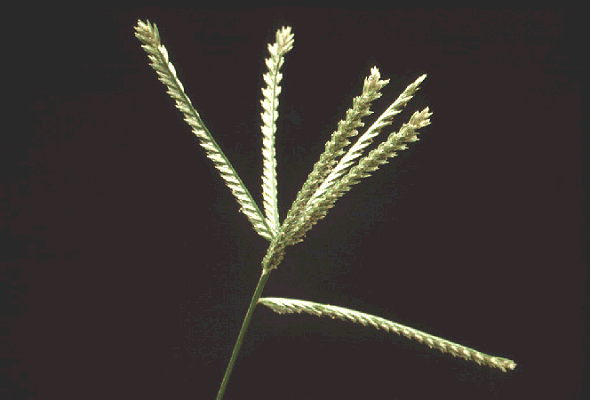Eleusine indica* (L.) Gaertn. Fruct.
1: 8 (1788).
Classification. (GPWG 2001) : Subfamily
Chloridoideae. Cynodonteae.
Basionym and/or
Replacement Name: Cynosurus
indicus L., Sp. Pl. 72–73 (1753).
Type of Basionym or
Protologue Information: LT: Burman, Thes. Zeylan. pl. 47, f. 1 (1737),
LT designated by Phillips in Cafferty et al., Taxon 49(2): 249 (2000).
Key references
(books and floras): [1878] G.Bentham, Flora Australiensis 7 (615),
[1952] C.A.Gardner, Flora of Western Australia 1 Gramineae (207),
[1969] E.E.Henty, Manual Grasses New Guinea (88), [1981]
M.Lazarides in J.Jessop (ed)., Flora of Central Australia (462), [2002]
D.Sharp & B.K.Simon, AusGrass, Grasses of Australia, [2006]
J.Jessop, G.R.M.Dashorst, F.M.James, Grasses of South Australia (355),
[2008] S.W.L.Jacobs, R.D.B.Walley & D.J.B.Wheeler, Grasses of New South
Wales (235).
Illustrations:
[1952] C.A.Gardner, Flora of Western Australia 1 Gramineae (206,
Pl. 61), [1984] N.T.Burbidge. rev. S.W.L.Jacobs, Australian Grasses (127), [2006] J.Jessop, G.R.M.Dashorst,
F.M.James, Grasses of South Australia (356, fig. 286), [2008] S.W.L.Jacobs,
R.D.B.Whalley & D.J.B.Wheeler, Grasses of New South Wales, 4th edn
(235).
Habit. Annual
or perennial. Culms erect or geniculately ascending or decumbent or prostrate,
stature slender to delicate, 15–100 cm tall. Leaves mostly basal. Ligule an
eciliate membrane, 0.6–1 mm long, truncate. Leaf-blades flat or conduplicate,
5–40 cm long, 2.5–8 mm wide.
Inflorescence.
Inflorescence digitate or subdigitate, with spicate branches. Racemes
1–10(–18), 3.5–15.5 cm long, 3–7 mm wide.
Spikelets.
Spikelets sessile. Fertile spikelets many flowered, with at least 2 fertile
florets (3–5(-9)), comprising 3–5(–9) fertile floret(s), with diminished florets
at the apex, elliptic, laterally compressed, 4–7.8 mm long.
Glumes. Glumes
similar. Lower glume lanceolate, membranous, keeled, 1-keeled, winged on keel,
1 -nerved. Upper glume elliptic, 1.8–24.3 mm long, membranous, keeled,
1-keeled, winged on keel, 3 -nerved (with subsidiaries in keel).
Florets.
Fertile lemma 2.1–4 mm long, keeled, winged on keel, 3 -nerved (excluding
subsidiaries). Lemma apex muticous. Palea 2 -nerved. Lodicules present. Grain
1–1.3 mm long.
Continental
Distribution: Europe, Africa, Temperate Asia, Tropical Asia, Australasia,
Pacific, North America, South America, and Antarctica.
Australian
Distribution: Western Australia, Northern Territory, South Australia,
Queensland, New South Wales, Victoria, Norfolk I, Lord Howe, Christmas Is, Cocos
Keeling Is, Ashmore Reef, Coral Sea Is.
Western Australia:
Gardner, Dampier. Drummond. Northern Territory: Darwin & Gulf,
Central Australia South. South Australia: Eyre Peninsula, Northern
Lofty, Murray, Southern Lofty, South-eastern. Queensland: Burke,
Burnett, Cook, Darling Downs, Leichhardt, Maranoa, Moreton, North Kennedy, Port
Curtis, South Kennedy, Warrego, Wide Bay. New South Wales: North Coast,
Central Coast, South Coast, Northern Tablelands, Southern Tablelands,
North-Western Slopes, North-Western Plains, South-Western Plains. Victoria:
Gippsland Highlands, Gippsland Plain, Midlands, Murray Mallee, Otway Plain,
Riverina, Volcanic Plain.
Notes.
Cosmopolitan weed, grown occasionally for grain in some parts of the world.
Reported from Australia and elsewhere that young plants sometimes contain
hydrogen cyanide and are responsible for deaths of calves and sheep. Eleusine
oligostachya Link, as referred to in M.Holtze, Trans. & Proc. Roy.
Soc. South Australia 15: 4 (1892) is probably E. indica, as Holtze
is listing plants introduced to the Northern Territory in the 20 years prior to
1892.
Distinguished from the other common, weedy
species, E. tristachya, by the taller, more erect habit, narrower,
larger spikes, pilose leaf sheath margins and blades, and winged keels on the
lemmas and paleas.
Mostly
near the coast including off-shore islands, and around populated areas. More
remote localities are recorded from northern Australia, where it may be native;
distributed through the tropics and sub-tropics of the world, probably
originating in E or NE tropical Africa. Usually a weed of roadsides, waste
ground and cultivated land; flowers Feb.-June.





